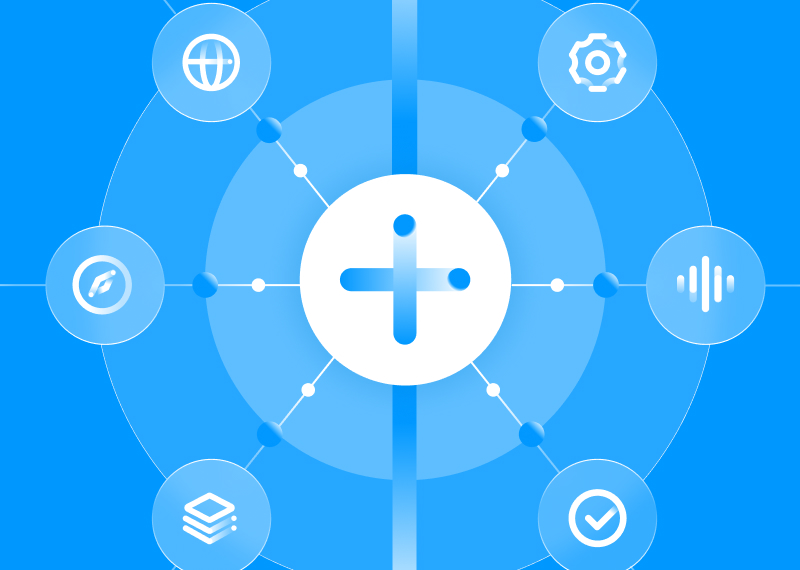Healthcare is a multifaceted sector, influenced by the ever-evolving medical science and circumstances across different regions. Additionally, lifestyle choices and social prosperity also have a causal effect on public health, adding layers of complexity to healthcare management.
Our recent 10Forward report delves into these complexities through a future-gazing framework and trend analysis, exploring healthcare advancements across four potential scenarios over the next decade. These scenarios highlight the critical interplay of technology, societal shifts and environmental challenges, underscoring the roles businesses play within our communities. We discuss emerging trends in healthcare such as digital twins for education, advanced AI decision-making systems to reduce manual workloads, intake and patient charting and assistive AR systems to monitor data and administer preventive therapies. Additionally, our report delves into established healthcare trends including personalized medicine and digital health platforms. The one constant we observe is the increasing demand for personalized and accessible healthcare, driven by both technology trends and patient expectations.
User-centricity in business model and technology design
The healthcare sector is witnessing a significant transformation in its business models, driven by the rise of direct-to-consumer (DTC) technology providers, an increasing focus on preventative care and patients expecting more personalized healthcare options. These shifts, often fueled by technological advancements that enable more tailored care based on individual needs, are fundamentally redefining how healthcare value is delivered and measured. The adoption of value-based care models, for instance, emphasizes a shift from focusing on the volume of services provided to prioritizing comprehensive, long-term patient health outcomes.
Central to this transformation are technologies such as wearables, computer vision and home health monitors, which support continuous, data-driven healthcare management outside conventional clinical settings. These tools facilitate new forms of patient engagement and care delivery, often transforming the home into a primary hub for healthcare and enabling patients to take active roles in managing their health.
Wearable devices are electronic technologies or sensors that are worn on the body, either as an accessory or part of the material used in clothing. These devices are designed to stay on the body to monitor health and fitness metrics over prolonged periods.
- Fitness trackers: devices such as Apple Watch or Fitbit monitor physical activities, heart rate, sleep patterns and more, helping users track their health and fitness goals. Advanced technologies embedded in these devices can also track health metrics such as ECG, blood oxygen levels, body temperature and even detect falls, sending alerts to HCP or family members in case of emergencies.
- Continuous glucose monitors (CGMs): Device like Zeo that can be worn on the arm as a patch continuously monitors the user’s glucose levels with real-time data on how different factors like diet, exercise and sleep affect blood sugar. This allows users to make informed decisions to manage their health more effectively.
Computer vision is a form of artificial intelligence (AI) that enables computers to identify visual information in videos and images. In healthcare, computer vision can leverage deep learning trained on medical image dataset to help doctors identify patterns and abnormalities. It can also be integrated into surgical tools to provide real-time visualization.
- Diagnostic imaging: Computer vision systems are increasingly being used to automate the analysis of medical images such as X-rays, MRIs and CT scans. These systems use advanced algorithms to detect patterns and anomalies that might indicate the presence of specific diseases or conditions.
- Augmented reality overlay: Surgeons are increasingly using 3D virtual reality models of patients' anatomy during surgical planning (augmented reality) to improve precision and reduce complications.
Home health monitors comprise a range of medical devices used at home to regularly check various health parameters. These devices can communicate data to HCP in real-time, supporting chronic disease management and post-hospitalization care.
- Blood pressure monitor: A medical device that allows patients to monitor their blood pressure at home and share readings with their doctors remotely.
- Remote patient monitoring (RPM): Home health monitors can be equipped with computer vision capabilities to help track the health status of patients remotely. For instance, specialized cameras and imaging technology can be used to monitor changes in skin condition, wound healing, and even signs of swelling or infection.
AI can further amplify this shift by personalizing patient interactions, predicting health trends and optimizing care paths through extensive data analysis. For example, AI-driven platforms can monitor data from wearable devices to anticipate exacerbations in chronic conditions like asthma or heart failure, enabling proactive healthcare interventions.
As healthcare providers increasingly adopt digital-first strategies, there is a growing emphasis on making these digital tools as accessible and user-friendly. This involves designing interfaces that are easy to navigate for all ages and abilities, ensuring that technology enhances rather than complicates the patient experience. On the flipside, it also means these solutions must not burden clinicians but rather fit into their routines and workflows, helping to improve efficiency without additional complexity or time.
Interoperability as a key enabler in healthcare
Interoperability stands as a fundamental enabler in user-centric healthcare technologies, crucial for both patients and providers. It ensures that various health IT systems and software can communicate and exchange data seamlessly. This capability is crucial for enhancing both the continuity and personalization of patient care. By facilitating access to a comprehensive, integrated view of a patient’s health data across different providers and care settings, interoperability supports more informed clinical decision-making and the development of personalized treatment plans tailored to individual patient needs.
Furthermore, interoperability trends underpin a more connected health experience, where data from wearable devices, electronic health records (EHRs) and other digital sources are synchronized. This data harmonization provides a cohesive and detailed overview of a patient’s health, significantly enhancing clinical decision-making and overall patient management. The uninterrupted flow of information is particularly vital for the management of chronic diseases and ensures that patient care is both coordinated and efficient, irrespective of the care setting.
The technological backbone of interoperability includes essential tools such as EHRs integrated with Fast Healthcare Interoperability Resources (FHIR) APIs. These technologies facilitate the robust exchange of health data, ensuring that critical patient information is readily available when and where it is needed, all while upholding the highest standards of data privacy and security.
Use cases across various healthcare settings that demonstrate the importance of seamless data exchange, highlighting its impact on enhancing patient care and optimizing clinical workflows:
- Surgical workflow optimization: Integrating surgical planning tools and documentation systems with EHRs streamlines the entire surgical process. This seamless connection enhances coordination among medical staff, reduces administrative overhead and improves patient outcomes by ensuring that all relevant information is readily accessible and up-to-date.
- Emergency room data integration: The integration of EHRs provides immediate access to critical patient information such as medical histories and current medications. This rapid data retrieval is crucial in urgent care scenarios, significantly improving response times and the accuracy of emergency interventions.
- Inpatient care: Utilizing standards like HL7v2® or FHIR® enables seamless data exchange across hospital departments. By integrating real-time patient monitoring systems with EHRs, healthcare providers receive instant updates on patient status, enhancing the efficiency and effectiveness of inpatient care.
- Chronic disease management: Effective management of chronic diseases requires a comprehensive approach that integrates data from multiple sources. By consolidating this information, healthcare providers can develop and implement personalized care plans tailored to individual patient needs, thereby improving long-term health outcomes and patient satisfaction.
To fully realize the potential of user-centric design in healthcare, it is imperative that these systems are underpinned by stringent data security measures. Patients’ willingness to engage with digital health solutions hinges significantly on their trust in the security and ethical use of their data. Establishing and maintaining this trust is foundational to any patient-centered health technology strategy. Robust security protocols not only protect patient information but also reinforce the reliability and credibility of the healthcare systems that patients depend on daily.
Empowering people to take better care of their health
The profound changes the healthcare sector is going through is also transforming patients from passive recipients of medical services into active participants in their health journey. With more connected care and personalized experiences on the rise, patients are now empowered to take charge of their health, supported by innovative business models and cutting-edge technologies.
Central to this transformation are wearable devices, which are playing an increasingly pivotal role in everyday health and well-being management. Many of them now go through rigorous Medical Device certification (Food and Drug Administration in the US and European Medical Device Regulation in EU) to ensure that the data they integrate is clinically relevant, giving health providers confidence in their use. Wearables are becoming integral to proactive health management, monitoring everything from infants' vital signs to alerting users about health irregularities through smartwatches. As individuals age, these devices, along with digital platforms, offer personalized health recommendations based on dietary preferences, exercise habits and genetic predispositions, ensuring that preventive care is consistent and tailored to each individual's unique health profile.
Insurance companies are also adapting to these changes by making preventive care and wellness more accessible. For instance, global insurance provider Vitality adjusts premiums based on individuals’ fitness activities, incentivizing healthy behaviors and integrating wellness into their business models. This shift towards value-based care models aligns financial incentives with long-term health outcomes, emphasizing the importance of preventive care.
The critical role of data in this new healthcare paradigm cannot be overstated. As healthcare shifts towards more personalized and preventive approaches, patients are increasingly empowered to manage their health through DTC technologies and services. Interoperability mentioned above ensures that patients can access their health data across different platforms and providers effortlessly. This seamless data exchange is essential for enabling patients to make informed decisions about their care and manage their health proactively.
Regulated vs non-regulated devices
The evolution of medical technology has significantly broadened the accessibility of health monitoring devices directly to consumers. This shift has fostered a critical distinction between non-regulated and regulated medical devices, which is pivotal for both safety and effectiveness in healthcare delivery.
Non-regulated devices include a wide range of health and fitness wearables such as basic step counters and sleep monitors, and are commonly available directly to consumers without the need for a prescription. These devices generally focus on wellness and lifestyle enhancements rather than specific health interventions. While they provide valuable health insights that can encourage healthier lifestyle choices, they do not require approval from regulatory bodies like FDA because they are not intended to diagnose, treat, cure or prevent any diseases.
In contrast, regulated medical devices are subject to stringent regulatory scrutiny because they play a direct role in diagnosing, treating or managing health conditions. These devices must demonstrate safety and efficacy through rigorous testing and clinical trials before receiving FDA clearance or approval. Once approved, many of these devices require a prescription from a healthcare professional. This oversight ensures that the device is used appropriately and integrated into the patient’s healthcare regimen under professional guidance, which is crucial for devices that directly impact medical treatments and outcomes.
However, the recent FDA approval of Dexcom’s first over-the-counter continuous glucose monitor Dexcom represents a significant shift towards making medical devices more accessible to the public. In this case, individuals who are non-insulin-dependent can better monitor their glucose levels for general wellness or minor health concerns with more autonomy.
In a user-centric healthcare system, care is tailored to the unique needs of each individual. This customization is made possible through the analysis of big data, encompassing everything from genetic profiles to lifestyle data collected through various tech devices. HCP can use this information to predict health risks and intervene before illnesses develop or worsen. Interoperability facilitates this by ensuring that all relevant data is available to providers when needed, enhancing the accuracy and effectiveness of personalized care plans.
Building trust through data security
Trust continues to play a critical role in healthcare for both patients and HCP as the sector increasingly embraces technology and data-driven approaches. Ensuring data security and privacy remains paramount; patients must feel confident that their sensitive information is protected and used responsibly. Additionally, trust in clinical validity of data collected from various devices, especially from non-regulated ones that most consumers have access to, is essential.
From a patient’s standpoint, the assurance that their health data is secure and that the medical devices they use are reliable and effective is fundamental to their willingness to engage with digital health solutions. This engagement is crucial for the successful implementation of patient-centered technologies such as telemedicine and wearables. Patients need to trust not only that their data is protected but also that the health insights derived from these devices are accurate and meaningful. Without this trust, the adoption of digital health technologies, which hinges on data, could stall, undermining efforts to advance personalized and preventive healthcare.
For HCP who rely on data to make informed decisions, they need reliable data so the care for their patients isn’t compromised. And if the integrity of the data is questionable – particularly from non-regulated devices – their ability to provide effective care could be compromised. Furthermore, as discussed in the previous section on interoperability, data needs to be seamlessly integrated into HCP’s existing workflow. Creating a connected digital ecosystem that fits within traditional practices, rather than disrupting them, is essential to truly providing more user-centered care.
To foster this essential trust, both device manufacturers and healthcare organizations must adhere to data protection and regulations such as HIPAA and GDPR. They need to educate both patients and HCP about the benefits of digital health solutions, along with transparent communication about data handling and device certification processes, will further help in building and maintaining this critical trust.
Healthcare technology trends: User-centricity & interoperability pave the way
While healthcare has traditionally been slow to change, the integration of user-centric designs, advanced interoperability and innovative business models is setting the stage for profound transformations. These developments promise to make healthcare more efficient, effective and personalized. Although some in the healthcare sector may be hesitant to embrace change, it's crucial to recognize that today's digital-native generation will be the HCP and clinicians of tomorrow. Across insights from our 10FWD trend reports and scenarios, technology is likely to play an even more pivotal role in our societal evolutions. The upcoming generation, with their familiarity with digital solutions, will drive the evolution toward a more responsive, patient-centered healthcare system. Maintaining a focus on interoperability and user-centricity will be key to realizing a healthcare system that continuously adapts to meet patient needs.











